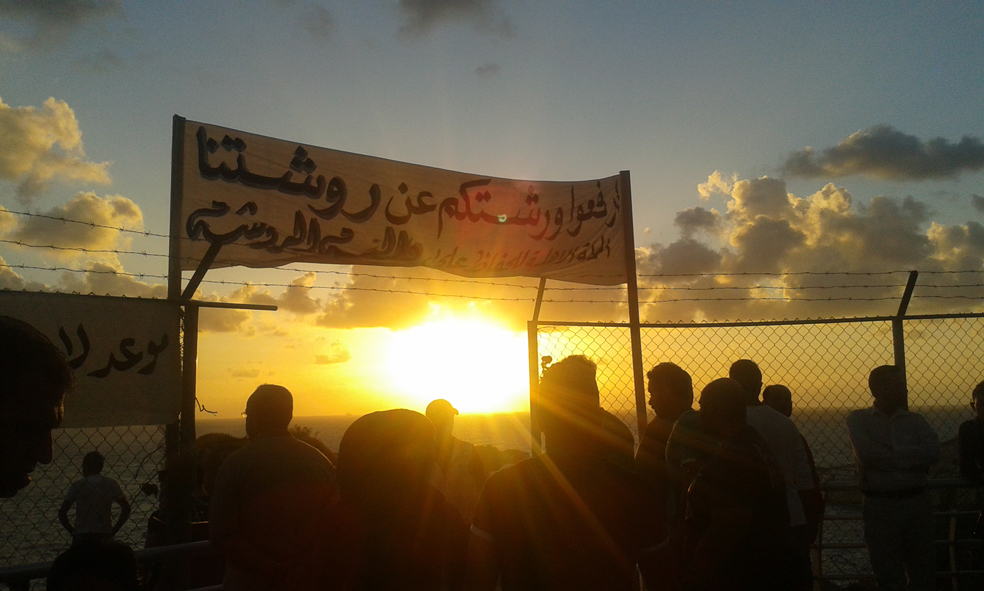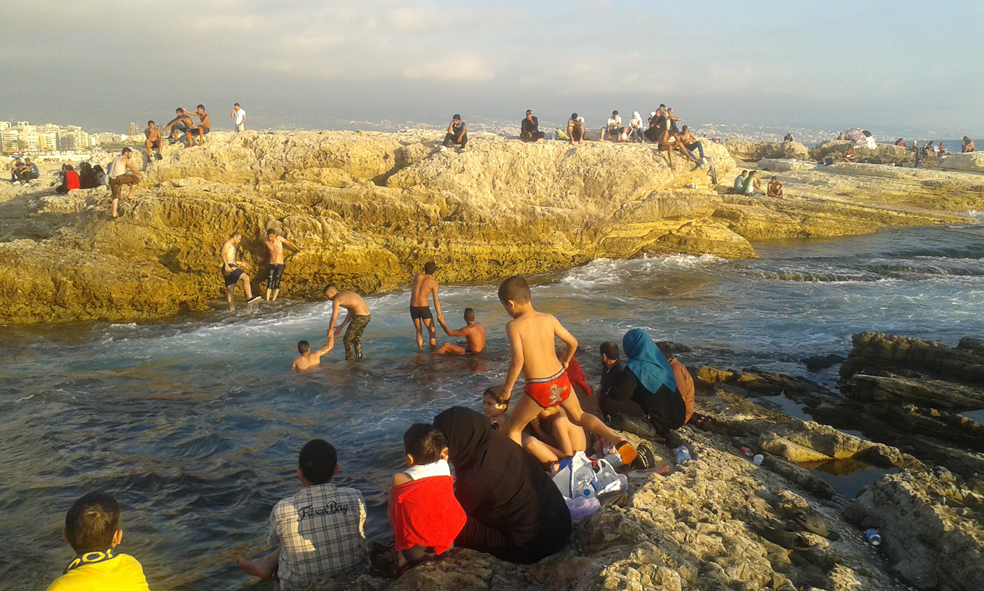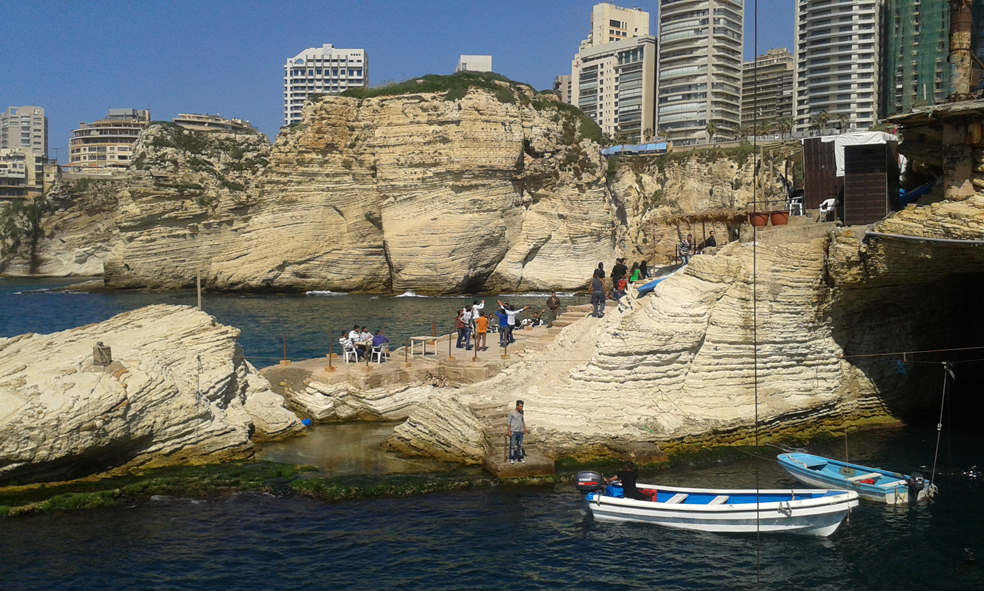We have recently learned that the Office for Metropolitan Architecture (OMA) has been commissioned to develop a design for a projected development on a prime sea-front location in Beirut (Lebanon): the Dalieh of Raoucheh. Proposing a private development over such a prime social, national, archeological and geological landmark in Lebanon has generated an ongoing public outcry, in the form of protests, letters to officials, discussions, and media mobilization. We are writing today to alert you to the disturbing facts behind the project, and solicit your support in outlining an alternative vision for Beirut’s seafront. Here are the facts fuelling the dispute over the project:
1. The project will erase an important social space and a national landmark
For decades, the site where the project is being designed has been a prime social and public gathering for Beirut dwellers, but also a national landmark for Lebanese citizens. The site included traditional fishermen ports, informal restaurants, and a vibrant informal economy that lived off such temporary recreational activities. These activities have recently been interrupted as the site was reclaimed as “private property,” and fenced-off, displacing its long-term users.
Adding to the social and symbolic significance of the site is its immediate proximity to the Raoucheh rock, perhaps the main city landmark that holds enormous symbolic significance at national and international scales. Frequently used as a metonym for Lebanon’s natural beauty, the Rock has appeared on national currency as well as in numerous films, histories, and imageries of the city. Any architectural intervention that modifies this seafront landscape, particularly one that privatizes a natural extension of this public landmark, will have resounding negative impacts.
2. The project will be built on property that was partially acquired illegally
Dalieh properties were the result of the visions of Ottoman and later French authorities to entrust the city’s commons to the main families of the city, as its custodians and protectors. Until 1995, these properties had multiple owners, who were all members of the so-called “old families of Beirut.” One investor managed to buy these property shares, consolidate single private ownership and expand it over what was the city’s collective commons. This take-over operation has been represented as a de-facto reality that overshadows the historical communal practices in Dalieh and represents them as illegal squatting of private land. This led to the fencing-off of the area and the subsequent prohibition of access to the sea.
Historical and contemporary property records we have obtained unequivocally demonstrate that property boundaries in the area have been modified to encroach on the public maritime domain, in contravention of the law. In other words, a large section of the area where the project is currently planned has been illegally privatized. This includes the fishermen port that, until recently, secured the livelihood of over seventy-five families, and also served as a recreational space for thousands of others. Implementing this project in this location will make theft of public land a fait accompli.
3. The project serves the narrow interests of an elite group of politicians and real-estate developers
While urban and building regulations had relatively protected Beirut’s seafront for decades, making of the promenade along the coast a landmark communal space in the city, regulations have been considerably modified over the past twenty-five years. Indeed, private real-estate developers have lobbied affiliate politicians to pass multiple exceptions to existing laws that serve their interests, allowing intensive building exploitation ratios at the expense of the city’s livability. The lobbyists behind these regulations are not only property owners, but also policy-makers, ministers, and other members of the political elite who have turned law into yet another tool that serves their private interests. Your client is a member of one of the most powerful players among that elite. Thus, while the entire zone of the project was non-ædificandi (unbuildable) until 1966, exploitation ratios have gradually increased reaching a whopping sixty percent rate, according to the most recent modification of April 2014. The effects of these exceptions to the law are clearly visible on the city, where miles of public beaches and open spaces have been turned into a gated private resorts and landscapes. A design intervention that works within this usurped legal framework will serve the interests of a handful of policy-makers/property-owners who are blatantly manipulating the law to their own advantage, at the detriment of the city, its natural environment, and its dwellers.
4. The project threatens a unique ecosystem
Numerous studies highlight the ecological value of this area, particularly as it includes representative marine habitats, namely underwater caves and vermetid reefs where a unique sea-life flourishes. We cite, for instance, the National Physical Master Plan of the Lebanese Territories (approved by decree 2366/2009) that identifies this site as a distinguished natural area of utmost importance to be protected, as well as Plan Vert de Beyrouth (2000) proposed by renowned architects and urbanists, the International Union for Conservation of Nature (IUCN) and Lebanon’s Ministry of Environment (2012), Greenpeace’s A Network of Marine Reserves in the Coastal Waters of Lebanon (2012)
5. The project will destroy a rich archeological site
The site is etched with features that could be traced back to the geological history of Lebanon. In fact, it may be the last remaining coastal karstic outcrop on the Beirut city coast, which is the backbone of the city’s visual landscape. Among other sites on the coastal strip, it is also by far the most extensive and important site that presents evidence of the Stone Age in the Levant.
In light of the above, we are appealing to you in your roles as founder and lead architect of the firm, and as an educator and a public intellectual, to side by us in advocating to your client, but also to planning and urban authorities in Beirut the preservation of a site with unique characteristics, and withdraw services on this project. If such advocacy efforts falter, we urge you to dissociate yourself and your firm from this contentious project.
We remain open, as a campaign, to meet with your office to discuss in more detail various aspects of this controversial project and this key national site.
Sincerely,
The Civil Campaign for the Protection of the Dalieh of Beirut
http://www.facebook.com/dalieh.org
[All images are authored by the Civil Campaign, unless indicated otherwise.]

[Banner on the Raoucheh`s Newly Added Fence: "Lift your Warcheh (Construction Site) Off Our Raoucheh!"]
[Bathing on a Warm Sunday].jpg)
[Diving Competition. Image courtesy of Dalieh`s fishermen.].jpg)
[Family Picnics].jpg)
[Nowruz Kurdish Celebration]
.jpg)
[Picnics Facing the Sea].jpg)
[Protest Against the New Fence Sealing Off the Access to Dalieh].jpg)
[Public Rally to Reclaim Dalieh]
[The Old Port which Provides Boat Rides for Visitors]